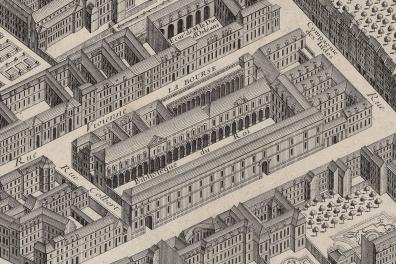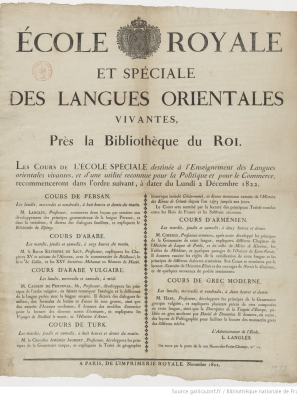Langues O' at the Bibliothèque nationale

Teachers offered four lessons per decade (the unit of measurement used by the Republican calendar, which divided the months into three dozen days), during which they introduced their listeners to the principles of language and text analysis. The School continued in this way until Antoine-Isaac Silvestre de Sacy's death in 1838. Other courses were added, such as Hindustani, Chinese and Japanese.

However, the limitations of the facility at the Bibliothèque nationale are sorely felt, and are repeatedly denounced by teachers and students alike. Indeed, although the President of the School is a member of the library's conservatory² and therefore has influence in the management of the establishment, the location of classrooms within the Quadrilatère Richelieu remains highly disabling. For example, the proximity of the busy rue Neuve-des Petits-Champs makes it difficult to listen to classes. What's more, students have yet to find their way to the School's premises, which are not signposted and are located in a remote wing of the library. This situation led to a reorganization project drawn up by students in 1848. In their memoir, they emphasized the "insalubrious character, and lost in the dark detours of a particular entrance to the national library" of the premises allocated to the École, and called for new premises to be made available³.
.

Following these repeated appeals, the École's operations were gradually reorganized by the imperial decrees of November 8, 1869 and June 8, 1870. The institution was temporarily transferred to the premises of the Collège de France before moving, in 1873, to 2 rue de Lille, which it still occupies today.
¹ Printing plate of the course program for year 9, November 1800, 62AJ 72 Archives nationales de Pierrefitte.
² Ordonnance du Roi portant Règlement de l'École royale et spéciale des langues orientales vivantes près la Bibliothèque du Roi du 22 mai 1838, F/17/4055, Archives nationales de Pierrefitte.
³ Mémoire de la commission déléguée par les élèves anciens et nouveaux de l'Ecole nationale des langues orientales et du collège de France, 1848, F/17/4054, Archives nationales de Pierrefitte.